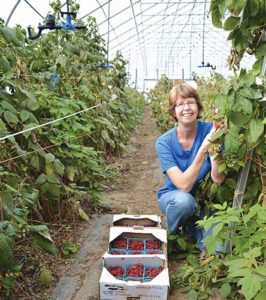 |
| Dale-Ila Riggs with a bountiful raspberry crop growing in her high tunnel. Photo courtesy of The Berry Patch |
By Jean English
For Dale-Ila Riggs and Don Miles of The Berry Patch in Stephentown, N.Y, about 10 miles from Pittsfield, Mass., berries helped their farm become a thriving, successful business. The Berry Patch is not certified organic, but the farmers often sell their crops as pesticide-free, thanks to the protection from insects that comes from growing in high and low tunnels. They discussed their operation at MOFGA’s 2019 Farmer to Farmer Conference. Dr. David Handley, vegetable and small fruit specialist at UMaine’s Highmoor Farm in Monmouth, moderated the session.
The couple married in 1982 and saved money until they found and bought land in 1995, when Riggs was working as a vegetable specialist at Cornell. The farm had a “dumpy old farm stand – but also on the property was a building that was one of the first farm stands in the United States,” said Riggs, and “The fields were worn out corn fields, but the soil was a nice gravelly sandy loam.” Also, it was on a road well-traveled by people returning to New York City from Vermont.
Riggs and Miles began farming part-time. They planted June-bearing strawberries (one-third acre of dormant bare root plants in matted rows), raspberries (tissue cultured plugs) and blueberries (6-inch whips from 2.5-inch pots) in 1996 and had their first harvest of strawberries in 1997, of raspberries in 1998 and of blueberries 1999. They picked what they could, and they sold pick-your-own strawberries from that first matted row planting. Riggs stopped working for Cooperative Extension in 1998, and they opened their first farm store in 1999, with limited hours.
Challenges and Opportunities
Among the early challenges was the weather. They are in a cold spot and had to irrigate for frost protection 11 times that first strawberry season, sleeping in a tent in the field so that they could start irrigating when the thermometer hit 32 F.
In 2002, 5 inches of snow fell on May 18 when early varieties were in full bloom and late varieties were starting to bloom. Then night temperatures fell to 16 F the night of the 18th, and they had five successive frigid nights with lows of 18, 20, 22 and 24 F. Their lack of equipment and of mechanical skills when the tractor that ran their irrigation pump wouldn’t start made frost protection a challenge, “but we made it through,” said Riggs. She realized, “I had to get really good at knowing when to turn on the irrigation and how to minimize the amount of time we were irrigating for frost. I delved into the science of irrigation. We made it through those five nights without losing a single blossom. We were the only berry grower in the Capital District to have strawberries that year.” Their beautiful rows with nice picking became an opportunity for them, but the stress and lack of sleep made Riggs realize the value of protected culture.
Marketing is another challenge, she continued. “Our first year we got into a hot, humid period. We had many beautiful berries, but few people knew we were around, so I put out an announcement saying all these berries need to be picked or they’ll go bad. We offered that any nonprofit organization could come and pick for free. But people didn’t read the ‘nonprofit organization,’ and hordes showed up to pick for themselves.” Meanwhile, a newspaper in nearby Pittsfield, Mass., wrote an editorial about “Strawberry Fields Forever” that made people aware of The Berry Patch. That huge amount of exposure for a first-year operation turned out to be great marketing, said Riggs.
They started their farm store in 1999, making improvements every year. By 2017 they had one heated greenhouse and four tunnels for protected culture. Over the years they had gone from a 91-acre farm with a mortgage, to a 215- and then a 240-acre farm with a mortgage, to being debt-free in 2017 – partly, said Riggs, because people have a hard time saying “no” to fresh berries that look beautiful, have a high sugar content and are a nice color throughout. People also like picking in a field free of weeds with lots of straw mulch and with lots of plants loaded with multiple berry clusters and nice big berries. “Our system is organized,” said Riggs, “with flags noting where to start picking and where picking ended. If you have a quality crop, you can do well with berries.”
Some Keys to Success
Keys to success have included having drip irrigation on the whole farm for berries; understanding plant physiology to know critical times for certain cultural practices; thinking about how to do things differently, such as giving the crop away one summer; moving to off-season production with more everbearing strawberries; and engaging customers. “We do a lot of customer education,” said Riggs. “Most people don’t know about differences in varieties.” She has done two on-air strawberry tastings on a radio show as part of this education.
They grow six to eight June-bearing varieties for a long season, including the “workhorses” Annapolis (early), L’Amour (midseason) and Jewel (late season).
Changes
Over time changes in consumer behavior led to changes on the farm. At first a lot of people picked for freezing or making jam, so the more they picked, the cheaper the price was per pound. Now people come for entertainment and pick 2 quarts of strawberries. “Entertainment is not my thing,” said Riggs, “so we decreased the amount of you-pick.”
Climate change has also altered their practices. “We used to go to great lengths with row covers to get berries in earlier and to have as long a season as possible, but our seasons have changed. We’re getting strawberries on June 10 without row covers in most years now. School gets out the last week of June, so it’s not good to have a lot of berries for pick-your-own in the second week of June. So we’re trying to delay the crop.”
Because they sell through their farm store, the Troy, N.Y., Farmers’ Market and restaurants in the Berkshires, they ended up diversifying and growing vegetables as well as berries.
They have recently made changes to create a different lifestyle. “May and June were always so stressful,” said Riggs. “By July 10 or so, the strawberry season was done, we’d be exhausted, and we would have the entire rest of the farming season still to come. We would rather have time for a bike ride or a hike than be at the farm from 8 a.m. to 8:30 p.m. seven days per week.”
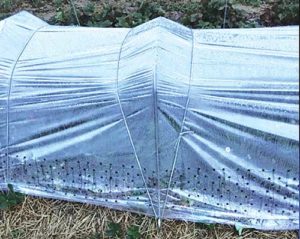 |
| Strawberries grow in low tunnels covered with clear plastic with ventilation holes. Photo courtesy of The Berry Patch |
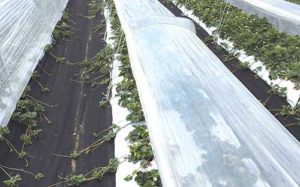 |
| Riggs controls weeds with black weed mat between beds and white on black plastic (to avoid heat buildup) within rows. Photo courtesy of The Berry Patch |
Low Tunnels
Protected culture and low tunnels also led to changes. With everbearing strawberries in low tunnels, “instead of having to make it or break it in three to four weeks in June, we can have berries in late July or August and into October when nobody else has berries,” said Riggs. The low tunnels consist of lightweight metal frames about 24 inches high covered with clear plastic with ventilation holes. Bungee cords hold the plastic to the frames. The farmers can set up these tunnels in a day, and thanks to low tunnels, they can pick quality berries even after a heavy rain. The plastic sides stay down unless the temperature exceeds 70 F on a warm, sunny day; then bungee cords hold the plastic up near the shoulders of the frames.
Riggs said that nutrition with everbearing strawberries may be a challenge for organic growers because of the long season of production. They plant a legume green manure a couple of years before planting, followed by oats or other cover crops so that they have 6 to 7% organic matter, even in their gravelly sandy loam. They use synthetic fertilizers through the drip system. Riggs applies 1 to 2 pounds of nitrogen per acre per week through the drip system through bloom, and 5 to 7 pounds per acre per week, also through drip, once fruit have set. Much more work is needed on the nutrition of everbearers, said Riggs. Organic matter may not mineralize enough during their production time to provide the needed nitrogen.
Pests and Diseases
Tarnished plant bugs have not been an issue as long as Riggs and Miles keep weeds down and avoid mowing around the edges of the planting when strawberries are blooming. Mites build up under tunnels but are easily controlled with beneficial mites. Riggs sprayed twice for spotted wing drosophila (SWD) in strawberries grown under low tunnels outdoors. To minimize SWD damage, Riggs said, “Pick strawberries every other day, keep them cool, and eat them within 24 hours.” Handley added, “If your pickers see SWD, they should tell you.”
Leaf spot is minimal if tunnels are managed well so that berries don’t get wet. And botrytis is almost nonexistent when good management keeps moisture out of tunnels. “If you see a thunderstorm coming, lower the sides,” said Riggs. She noted that new plastics are being researched that help reduce spore germination.
Riggs and Miles now use black weed mat between beds and white on black plastic (to avoid heat buildup) within rows for weed control. They run the weed mat up slightly onto the plastic on the bed and staple it there to avoid having a line of weeds where the mat meets the plastic mulch. Two rows of plants grow on each strip of plastic. Their crew cleans weeds from planting holes once or twice per season.
Early Planting Is Key
Early planting of day-neutral varieties of strawberries is critical for success. Riggs said that Courtney Weber at the New York State Agricultural Experiment Station in Geneva found that day-neutrals should be planted by May 1 or yields go down. Weber achieved greatest yields when plants went in on April 15 and April 30. If you buy dormant plants when you can’t get them planted, Riggs advised trimming the roots and sticking the plants in 50-cell plugs. “They’ll start to grow, and you can then plant them with a water wheel transplanter like any other vegetable crop.”
Riggs related that one year, at the end of the season, when they had row cover fabric over the tunnels, 2 inches of very wet snow fell and bent their hoops. “So when you get to the end of the season and it’s getting cold, think carefully if you really want to use row cover or just let the plants go,” she advised.
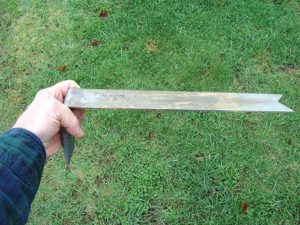 |
| A strawberry planting tool made from 2-inch, flat rebar. Photo courtesy of David Handley |
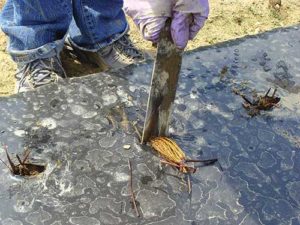 |
| The planting tool grabs the root and pulls the root system into the ground while the grower holds the crown of the plant. Photo courtesy of David Handley |
Annual Costs and Returns
Riggs presented these annual figures (rounded) for costs and returns:
$600 Hoops for 1,600 linear feet of bed (about one-quarter acre) cost $3,000 when Riggs and Miles bought them. They should last five years or more and can be used on other crops, including melons.
$515 3,000 plants, current price
$640 Labor to set up hoops: 32 hours @ $20 per hour
$640 Labor to manage plastic and runners if you choose to cut runners. (They don’t.)
$750 Plastic mulch, drip system, weed mat
$3,145 Total
The Berry Patch produces over 3,350 pints, and sometimes 3,800 pints. They wholesale to restaurants for $4 per pint and retail for $5 per pint.
Overwintering and Producing Plants
Riggs and Miles have not had much success overwintering day-neutral strawberries, despite trying straw, row cover and straw plus row cover. Albion, their main day-neutral variety, seems to be the least winter hardy. Riggs thinks Albion bears too late into the fall (especially if it is fertilized in the fall) to store enough carbohydrates in the roots to survive the winter. San Andreas has overwintered better, but it seems to be more susceptible to gray mold, and the flavor isn’t as good as Albion or Seascape, so she’s dropping it. Seascape was intermediate in winter survival.
Handley added that colder, shorter days stimulate plants to produce more branch crowns, leading the following year to a big, bushy plant with more insect and disease problems and smaller fruits.
Asked about producing one’s own plants, Handley said that when runners have root buds in July, growers could stick them in a 50-plug tray and they’ll root in three to four weeks. Then overwinter them in cold storage and plant them the following year. “It would take a lot of labor,” said Handley, but you could do batches and stagger the planting dates.
Handley said that removing runners resulted in significant yield increases at Highmoor Farm. Albion doesn’t produce that many runners until fairly late, and then it produces many, vigorous runners, he said. One grower found that time spent cutting runners eliminated his profit, so Handley suggested that he clip them with ear tag removers. Used to remove ear tags from animals and costing 50 cents each in bulk, they tripled the number of runners the grower could cut in a given time compared with using clippers.
Riggs buys dormant plants (not plugs), cuts the roots at 2 to 3 inches long and plants with a water wheel planter, finishing the job in an hour or two. Trimming down the roots seems to have no ill effects and prevents setting roots in a U-shape (from which they won’t recover).
Handley described a planter for a small planting, for those without a water wheel transplanter. (See photos.) “Buy a 2-inch piece of flat bar, take about 12 inches and leave it, then bend a handle off of it about 2 inches long and wrap it in duct tape. On the planting end, grind a crescent shape so that you have two points on the edge. Lay plants on the plastic mulch with the roots out the distance you want them. Put the crescent out over the end of the roots – you need about a half-inch to grab – and then push straight down. It will grab the root and pull the root system down. Hold the crown until it’s at the proper depth (about halfway up the crown) and pull the bar straight up. It pushes it right through the plastic and doesn’t leave a big space for weeds to emerge.” He also advised, when cutting roots before planting, to try not to remove more than 25 percent. An old potato planter also works for strawberry plants, he added.
High Tunnel Raspberries and Blueberries
Riggs and Miles also grow fall-bearing raspberries in high tunnels. Factors to consider for such an operation, said Riggs, are the type of structure (from simple hoops to an unheated greenhouse like they have), whether to use year-round or two-season plastic like a Haygrove, whether to produce a summer or fall crop or both, marketing, varieties, nutrition, pests, opportunity costs, and how the crop fits with the rest of your operation.
“Expect lots of vigor with protected culture raspberries,” said Riggs. “A raspberry plant in the open field that might get 4 or 5 feet tall will be 6 to 8 feet tall in a tunnel.” They grow Polana, which produces by the end of July, and Caroline, which was still producing in early November, and trellis them on both sides to form a V to open up the canopy. They’ve had the same plants in the tunnels for 12 years.
In 2012 Riggs noticed that the plants were not looking great, and by August 2013 they looked terrible. Leaf tissue testing indicated boron (B) and potassium (K) deficiencies. She added the equivalent of 1 pound per acre of B as Solubor through a fixed sprayer system in September 2013 and another 0.3 pounds per acre B in spring 2014 through a backpack sprayer as plants were starting to come up. Tissue samples in June showed that K was still low but B was in the correct range, and the plants looked fine. Further leaf sampling in August 2014 showed that B was still fine and K was still low.
“This mimics what I’ve seen in tunnel production of most crops,” said Riggs: Soil tests indicate that K levels are high enough, but so much biomass is produced so quickly that plants cannot take up enough K. Soil tests are calibrated for outdoor rather than tunnel production. “So we now inject K through the drip system every 10 days through the fruiting season. Our tissue tests came back fine once we started doing that. We have nice big fruit and tall canes again.”
They drip irrigate raspberries about three times a week.
Pests include two-spotted mites, which are easily controlled with beneficial mites. “Just sprinkle them on the leaves,” said Riggs. She does one release of Neoseiulus fallacis when plants are about 18 inches high and Neoseiulus californicus when plants are 2.5 to 3 feet tall, and that has eliminated any issues with two-spotted mites. Phytosieulus persimilis are more expensive, Riggs noted, and californicus will eat the eggs of persimilis.
For SWD, exclusion netting on their tunnel has resulted in less than 2% infestation. They also harvest six to seven days a week to make sure nothing gets overripe, and they get berries into a cooler right away. They tell customers not to store berries on the counter but to put them in the refrigerator, taking them out a couple of hours before eating and washing them just before eating.
They also grow blueberries under cover to avoid SWD. The plants require an acidic pH, drip irrigation, annual mulching and heavy pruning.
Growing Smaller
Riggs said they now grow a smaller amount of berries and do a good job with them. They rent their farm store to a young couple and sell only at the farmers’ market and to restaurants. “We’re having the highest sales we’ve had in 10 years at the market this year. Less is more,” she concluded.
